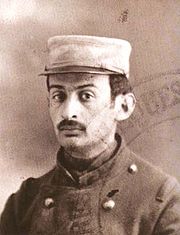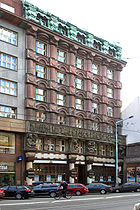
Otto Gutfreund
Encyclopedia

Cubism
Cubism was a 20th century avant-garde art movement, pioneered by Pablo Picasso and Georges Braque, that revolutionized European painting and sculpture, and inspired related movements in music, literature and architecture...
sculptor. He is acknowledged by the art historian Douglas Cooper to be the author of the first cubist sculpture
Cubist sculpture
Cubist sculpture is a style developed in parallel with cubist painting, centered in Paris, beginning around 1909 and evolving through the early 1920s.The style is most closely associated with the formal experiments of Georges Braque and Pablo Picasso...
: Anxiety (Úzkost in Czech), created in 1911 and exhibited in Paris
Paris
Paris is the capital and largest city in France, situated on the river Seine, in northern France, at the heart of the Île-de-France region...
in 1912.
Life
.jpg)
.jpg)

Dvur Králové nad Labem
Dvůr Králové nad Labem river valley.Dvůr Králové was first mentioned in 1270. It was a dowry town, owned by the King's wife and responsible for her expenses when her husband died. Today, it is a center of the textile and machinery industries....
, Bohemia
Bohemia
Bohemia is a historical region in central Europe, occupying the western two-thirds of the traditional Czech Lands. It is located in the contemporary Czech Republic with its capital in Prague...
, as the 4th of 5 children of Karel and Emilie Gutfreund. During 1903–1906 he studied at Škola výtvarných umění (School of Creative Arts) in the town of Bechyně
Bechyne
Bechyně , is a town in the South Bohemian Region of the Czech Republic. It is located on the Lužnice River 20 km southwest of Tábor and has a population of 5,695 ....
. After completion, he attended Umělecko-průmyslová škola (College of Decorative Arts) in Prague
Prague
Prague is the capital and largest city of the Czech Republic. Situated in the north-west of the country on the Vltava river, the city is home to about 1.3 million people, while its metropolitan area is estimated to have a population of over 2.3 million...
for the next three years. In 1909 Gutfreund discovered the works of Antoine Bourdelle
Antoine Bourdelle
Antoine Bourdelle , originally Émile Antoine Bourdelle, was an influential and prolific French sculptor, painter, and teacher.-Career:...
during his exhibition in Prague organized by the artistic group SVU Mánes
Mánes Union of Fine Arts
The Manes Association of Fine Artists was an artists' association and exhibition society founded in 1887 in Prague and named after the painter Josef Mánes....
. In November Gutfreund travelled to Paris and enrolled to study at Bourdelle’s sculpture class at Grande Chaumiere academy. In Paris he met Auguste Rodin
Auguste Rodin
François-Auguste-René Rodin , known as Auguste Rodin , was a French sculptor. Although Rodin is generally considered the progenitor of modern sculpture, he did not set out to rebel against the past...
and discovered medieval art. After a year Gutfreund left Bourdelle’s teaching course and travelled to Great Britain
Great Britain
Great Britain or Britain is an island situated to the northwest of Continental Europe. It is the ninth largest island in the world, and the largest European island, as well as the largest of the British Isles...
, Belgium
Belgium
Belgium , officially the Kingdom of Belgium, is a federal state in Western Europe. It is a founding member of the European Union and hosts the EU's headquarters, and those of several other major international organisations such as NATO.Belgium is also a member of, or affiliated to, many...
, and the Netherlands before returning to Prague.
In 1911 Gutfreund became a member of Skupina výtvarných umělců (Group of Creative Artists) in Prague and exhibited there his first cubist sculpture Úzkost (Anxiety). The next year he participated in the second exhibition of the Group and showed his works Hamlet, Harmony and Concert. Between 1913 and 1914 he used the principles of analytical cubism in his work. In the third exhibition Gutfreund displayed the cubist works Viki and Head with a Hat. He exhibited at Der Sturm
Der Sturm
Der Sturm was a magazine covering the expressionism movement founded in Berlin in 1910 by Herwarth Walden. It ran weekly until monthly in 1914, and became a quarterly in 1924 until it ceased publication in 1932....
gallery in Berlin
Berlin
Berlin is the capital city of Germany and is one of the 16 states of Germany. With a population of 3.45 million people, Berlin is Germany's largest city. It is the second most populous city proper and the seventh most populous urban area in the European Union...
and at the fourth Group exhibition in Prague. In 1914 he travelled to Paris where he met Pablo Picasso
Pablo Picasso
Pablo Diego José Francisco de Paula Juan Nepomuceno María de los Remedios Cipriano de la Santísima Trinidad Ruiz y Picasso known as Pablo Ruiz Picasso was a Spanish expatriate painter, sculptor, printmaker, ceramicist, and stage designer, one of the greatest and most influential artists of the...
, Juan Gris
Juan Gris
José Victoriano González-Pérez , better known as Juan Gris, was a Spanish painter and sculptor who lived and worked in France most of his life...
, Guillaume Apollinaire
Guillaume Apollinaire
Wilhelm Albert Włodzimierz Apolinary Kostrowicki, known as Guillaume Apollinaire was a French poet, playwright, short story writer, novelist, and art critic born in Italy to a Polish mother....
and Daniel-Henry Kahnweiler.
At the declaration of the First World War
World War I
World War I , which was predominantly called the World War or the Great War from its occurrence until 1939, and the First World War or World War I thereafter, was a major war centred in Europe that began on 28 July 1914 and lasted until 11 November 1918...
Gutfreund was in Paris and decided to join the French Foreign Legion
French Foreign Legion
The French Foreign Legion is a unique military service wing of the French Army established in 1831. The foreign legion was exclusively created for foreign nationals willing to serve in the French Armed Forces...
. He participated at the fighting on the Somme
Somme
Somme is a department of France, located in the north of the country and named after the Somme river. It is part of the Picardy region of France....
, at L'Artois and Champagne
Champagne, France
Champagne is a historic province in the northeast of France, now best known for the sparkling white wine that bears its name.Formerly ruled by the counts of Champagne, its western edge is about 100 miles east of Paris. The cities of Troyes, Reims, and Épernay are the commercial centers of the area...
. In 1915 he applied to join the French Army
French Army
The French Army, officially the Armée de Terre , is the land-based and largest component of the French Armed Forces.As of 2010, the army employs 123,100 regulars, 18,350 part-time reservists and 7,700 Legionnaires. All soldiers are professionals, following the suspension of conscription, voted in...
and the following year had been imprisoned after his application was refused both for the French Army and the Czechoslovak Legion. He spent two years in Saint-Michel-de-Frigolet prison camp near Bouches-du-Rhône
Bouches-du-Rhône
Bouches-du-Rhône is a department in the south of France named after the mouth of the Rhône River. It is the most populous department of the Provence-Alpes-Côte d'Azur region. Its INSEE and postal code is 13.-History of the department:...
. In 1918 he was moved to a civilian camp at Blanzy
Blanzy
Blanzy is a commune in the Saône-et-Loire department in the region of Bourgogne in eastern France.-Geography:The Bourbince forms part of the commune's north-eastern border, then flows southwestward through the middle of the commune.-References:*...
and after his release he settled in Paris to continue his work. For a short time he returned to Prague to accept a membership of the artistic group SVU Mánes.
In 1920 Gutfreund moved permanently to Czechoslovakia
Czechoslovakia
Czechoslovakia or Czecho-Slovakia was a sovereign state in Central Europe which existed from October 1918, when it declared its independence from the Austro-Hungarian Empire, until 1992...
and lived in Prague and his birth-place town Dvůr Králové nad Labem. His works of the 1920s are generally realistic in form, and exemplify the postwar "return to order
Return to order
The return to order was a European art movement that followed the First World War, rejecting the extreme avant-garde art of the years up to 1918 and taking its inspiration from traditional art instead. The movement was a reaction to the War...
" in the arts. He executed many small works in polychrome
Polychrome
Polychrome is one of the terms used to describe the use of multiple colors in one entity. It has also been defined as "The practice of decorating architectural elements, sculpture, etc., in a variety of colors." Polychromatic light is composed of a number of different wavelengths...
ceramic, such as the Textile Worker (1921) in the National Gallery in Prague
National Gallery in Prague
The National Gallery in Prague is a state-owned art gallery in Prague, Czech Republic. It is housed in different locations within the city, the largest being the Veletržní Palác....
. In 1921 he participated at the third exhibition of Tvrdošíjní held in Prague, Brno
Brno
Brno by population and area is the second largest city in the Czech Republic, the largest Moravian city, and the historical capital city of the Margraviate of Moravia. Brno is the administrative centre of the South Moravian Region where it forms a separate district Brno-City District...
and Košice
Košice
Košice is a city in eastern Slovakia. It is situated on the river Hornád at the eastern reaches of the Slovak Ore Mountains, near the border with Hungary...
. In 1924 he exhibited at the Exhibition of Modern Czechoslovak Art in Paris and in 1925 in the Czechoslovak Pavilion of International Decorative Arts Exhibition in Paris. The following year Gutfreund was made a professor of architectural sculpture at Umělecko-průmyslová škola (College of Decorative Arts) in Prague and took part in the Société Anonyme exhibition in New York
New York
New York is a state in the Northeastern region of the United States. It is the nation's third most populous state. New York is bordered by New Jersey and Pennsylvania to the south, and by Connecticut, Massachusetts and Vermont to the east...
.
On 2 June 1927 Gutfreund, at the height of his artistic powers, drowned in the river Vltava
Vltava
The Vltava is the longest river in the Czech Republic, running north from its source in Šumava through Český Krumlov, České Budějovice, and Prague, merging with the Elbe at Mělník...
in Prague
Prague
Prague is the capital and largest city of the Czech Republic. Situated in the north-west of the country on the Vltava river, the city is home to about 1.3 million people, while its metropolitan area is estimated to have a population of over 2.3 million...
.
Selection of works
- Anxiety (1911–1912)
- Hamlet II (1912)
- Don Quixote (1911–12)
- Viki (1912–13)
- Cellist (1912–13)
- Head with a hat (1913–14)
- Group: Lovers (1913–14)
- Head (1916)
- Sitting Woman (1916)
- Woman’s Head (1919)
- Mask with a Necklace (1919–20)
- Own Portrait (1919)
- Legions’ Return – relief on Josef GočárJosef GocárJosef Gočár , was a Czech architect, one of the founders of modern architecture in Czechoslovakia....
's Legiobank Building, Prague (1922–23) - Portrait of Artist’s Wife (1923)
- Sitting Woman II (1927)
Literature
- Jiří Šetlík: Otto Gutfreund – Zázemí tvorby, OdeonOdeonOdea, Odeon, or Odeum may refer to:* Odeon , ancient Greek and Roman buildings built for singing exercises, musical shows and poetry competitions-Modern era:* Cineplex Odeon, North America...
, Praha 1989 - Jiří Šetlík a kolektiv: Otto Gutfreund, Národní galerie v Praze, 1995–1996
- Michal Novotný: Jistý pan G., DauphinDauphinThe Dauphin of France —strictly, The Dauphin of Viennois —was the title given to the heir apparent to the throne of France from 1350 to 1791, and from 1824 to 1830...
, Praha 2000

